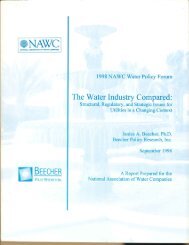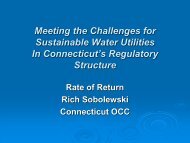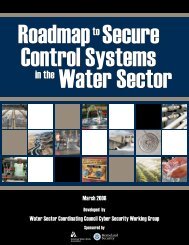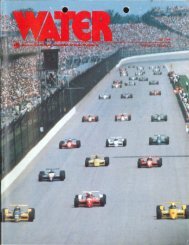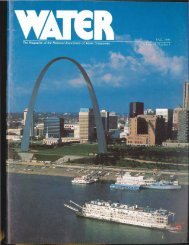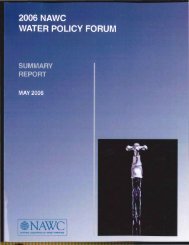CENTER FOR URBAN POLICY AND THE ENVIRONMENT - NAWC
CENTER FOR URBAN POLICY AND THE ENVIRONMENT - NAWC
CENTER FOR URBAN POLICY AND THE ENVIRONMENT - NAWC
Create successful ePaper yourself
Turn your PDF publications into a flip-book with our unique Google optimized e-Paper software.
Indiana University + School of Public & Environmental AffairsCenter for Urban Policy & the EnvironmentI. Currents of Change in Public Utilities and Their RegulationThe public utility infrastructure has been an essential part of the American landscape formore than a century. Energy, telecommunications, and water services in the United States havefostered growth, progress, and prosperity and set a standard rivaled around the globe. Over thesame time period, public utility regulation has been a fundamental tool of American public policy.For one hundred years, or so, these institutions generally were very stable. Today, the only realcertainty in the public utility industries and their regulation is change.Public utility services traditionally were considered monopolistic, primarily because ofeconomies of scale in production and delivery and limited opportunities for competition. Today,most utility monopolies are considered "artificial" rather than "natural," meaning that they existnot because of economic necessity but because of deliberate choices on the part of public policymakinginstitutions. In other words, monopolies supposedly are "made" not "born."Technological advances have brought about competitive opportunities in many of thepublic utility sectors. No where is this more apparent than in telecommunications, wherecompetition for long-distance and even local services has emerged. In the natural gas industry,market mechanisms play a central role in determining gas prices and some consumers have directaccess to the marketplace. Markets also are emerging in the electricity sector as experimentationwith retail wheeling begins. The "common carrier" or transportation industry has largely beentransformed to an openly competitive industry.As each of the public utility industries is transformed, so too is the regulatory frameworkunder which they operate. The states, through both legislative and regulatory bodies, are playinga very active role in restructuring the public utility industries. In the telecommunications area, thepace of restructuring has been particularly fast, stimulated in part by a new federal framework formarket reform. Many states have adopted variations of price cap regulation fortelecommunications providers, and local competition is allowed in a majority of the states (seeAppendix A).Regulatory changes also are underway for the electricity industry. A June 1996 report bythe Federal Energy Regulatory Commission (FERC), following a two-year investigation,concluded that deregulation at the retail level was feasible. California is leading the way inimplementing that vision. A 1995 California Public Utilities Commission decision will pave theway for wholesale and retail competition through the establishment of a power exchange, anindependent transmission system operator, and a phase-in plan for retail wheeling. 1 Most of thestate public utility commissions are considering restructuring and deregulation for the electricityindustry; interest in reform is greatest in states where electricity rates are highest. 2 Alternativestructural models for the electric industry are summarized in Table 1. Central to restructuring inthe electric industry is a new emphasis on competitive pricing and performance. 31Barbara R. Barkovich and Dianne V. Hawk, "Charting a New Course in California," IEEE Spectrum 33, no. 7(July 1996): 26-31.2Regulatory Research Associates, as reported in Hunt and Shuttleworth, 23.1



